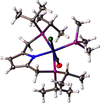issue contents
July 2017 issue

Cover illustration: A series of three iron complexes ligated by the pyrrole-based 2,5-bis[(diisopropylphosphanyl)methyl]pyrrolide (PNpyrP) pincer ligand are described. These complexes are possible precursors to new iron catalysts. See Holland, Oliver & Iluc [Acta Cryst. (2017), C73, 569-574].
research papers
Download citation


Download citation


This work demonstrates that flexible dicarboxylate ligands can be employed with CuII ions and linear N,N′-donor ligand systems to produce a two-dimensional wave-like network coordination polymer. The two-dimensional layers are expanded into a three-dimensional supramolecular structure through intermolecular O—H⋯O and C—H⋯O hydrogen bonds.
CCDC reference: 1534325
Download citation


Download citation


The first X-ray diffraction study of an (R1NH)P(O)(NH)2X diazaphosphole oxide (R1 and X are hydrocarbon groups) reveals that each molecule is connected with four neighbouring molecules through (N—H)2⋯O hydrogen bonds. These hydrogen bonds form a tubular arrangement along the [001] direction.
CCDC reference: 1435209
Download citation


Download citation


The reaction of copper sulfate with succinic acid (H2succ) and N,N-diethylethylenediamine (deed) produces a complex in which the metal centres are bridged by succinate ligands to form one-dimensional polymeric chains. Density functional theory (DFT) calculations were used to support the experimental data and a good linear correlation was observed between the experimental and theoretically predicted structural and spectroscopic parameters.
CCDC reference: 1554702
Download citation


Download citation


Proton transfer from sulfuric acid to isonicotinic acid leads to a salt in which a wide range of hydrogen bonds link the ionic residues. Hydrogensulfate and sulfate anions subtend the shortest O—H⋯O contact of 2.4752 (19) Å.
CCDC reference: 1553925
Download citation


Download citation


The crystal structure of 3-aminocarbonyl-1-benzylpyridinium bromide is reported, together with an improved-resolution structure of 1-benzyl-1,4-dihydropyridine-3-carboxamide. Taken together, these two crystal structures represent the most complete high-resolution structure model for the reactive portion of both NAD(P)+ and NAD(P)H.
Download citation


Download citation


The new salts 2,6-diamino-4-chloropyrimidinium 2-carboxy-3-nitrobenzoate and 2,6-diamino-4-chloropyrimidinium p-toluenesulfonate monohydrate have been synthesized and characterized by X-ray crystallography and their noncovalent interactions investigated.
Download citation


Download citation


A two-dimensional cadmium(II) coordination polymer was synthesized based on the V-shaped semi-rigid ligand 4,4′-[oxybis(4,1-phenylene)]dipyridine. In this structure, two identical two-dimensional (2D) layers are interpenetrated in a parallel fashion, resulting in a 2D→2D framework with both polyrotaxane and polycatenane features. The structure is further extended into a three-dimensional supramolecular network by extensive hydrogen bonds.
CCDC reference: 1479038
Download citation


Download citation


A novel Schiff base derived from indole and biphenyl has been designed, synthesized and fully characterized. Molecular docking indicated a good dihydroorotate dehydrogenase (DHODH) inhibitory activity and in vitro inhibition evaluation against lung and breast cancer cell growth proved the prediction.
CCDC reference: 1556543
Download citation


Download citation


The crystal structures of two 8-tert-butyl-7-methoxy-8-methyl-9-oxa-6-azaspiro[4.5]decane-2,10-dione enantiomers obtained by a method of stereoselective synthesis are stabilized by C—H⋯O hydrogen bonding, resulting in the formation of chains along the [100] and [010] directions. The conformation of the 3,6-dihydro-2H-1,4-oxazin-2-one fragment was compared with other crystal structures possessing this heterocyclic moiety.
Download citation


Download citation


The solvated/unsolvated character of the crotonate and salicylate salts of lamotriginium gives rise to extremely different hydrogen-bonded packing structures from the same elemental motifs.
Download citation


Download citation


A series of three iron complexes ligated by the pyrrole-based 2,5-bis[(diisopropylphosphanyl)methyl]pyrrolide (PNpyrP) pincer ligand are described. These complexes are possible precursors to new iron catalysts.
Download citation


Download citation


Two new kryptoracemates have been discovered. The asymmetric unit of these crystals contains two enantiomers, which are not related by any proper symmetry element. Although the two enantiomers have a very similar conformation, they are not transferable into each other by any symmetry element. In the crystal, molecules are connected by intermolecular N—H⋯O hydrogen bonds to form chains or layered structures.
Download citation


Download citation


The crystal structures of sodium magnesium selenate decahydrate, Na2Mg(SeO4)2·10H2O, a new selenate salt, and sodium magnesium selenate dihydrate, Na2Mg(SeO4)2·2H2O, are described and compared.


 journal menu
journal menu






























